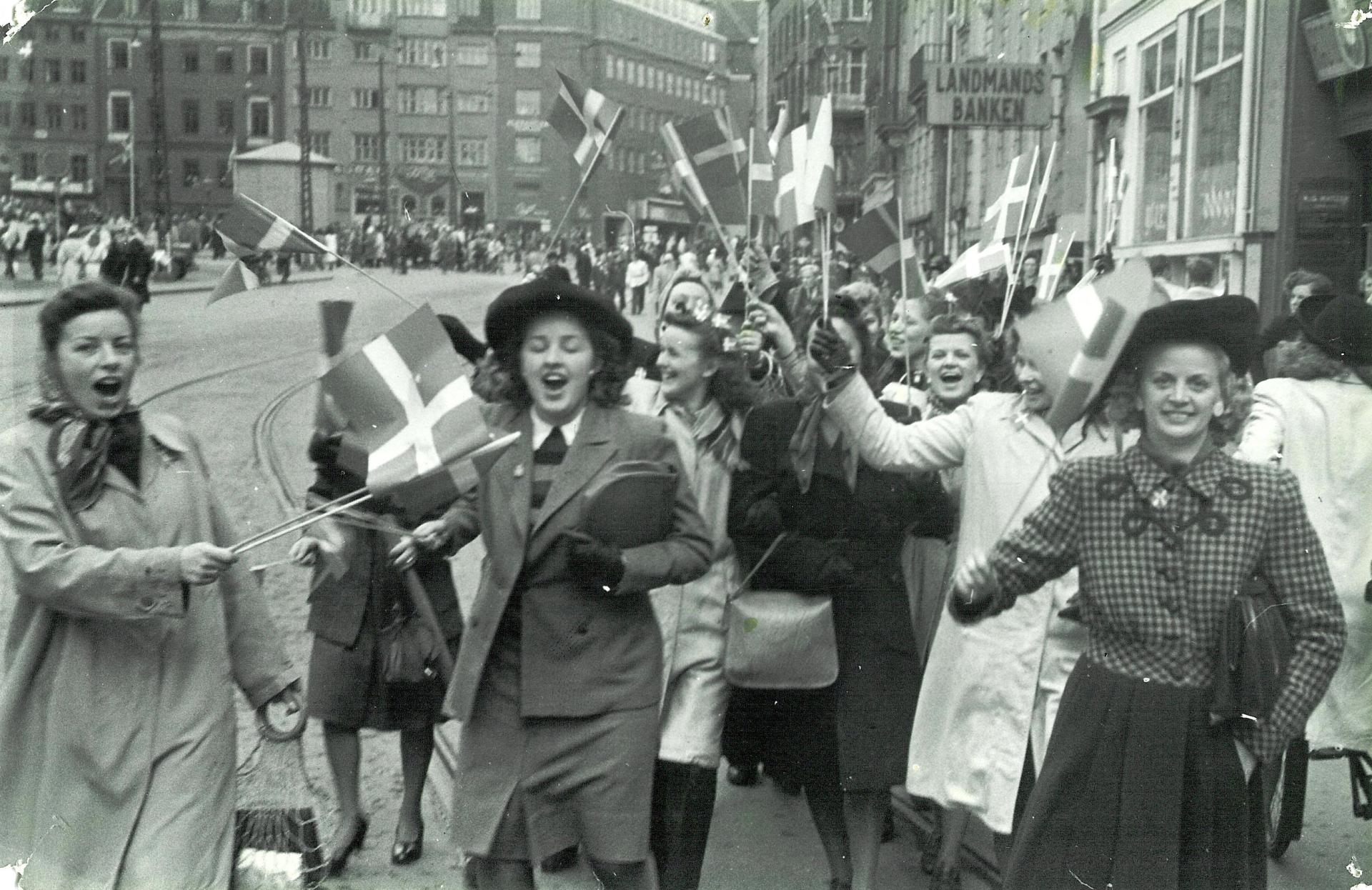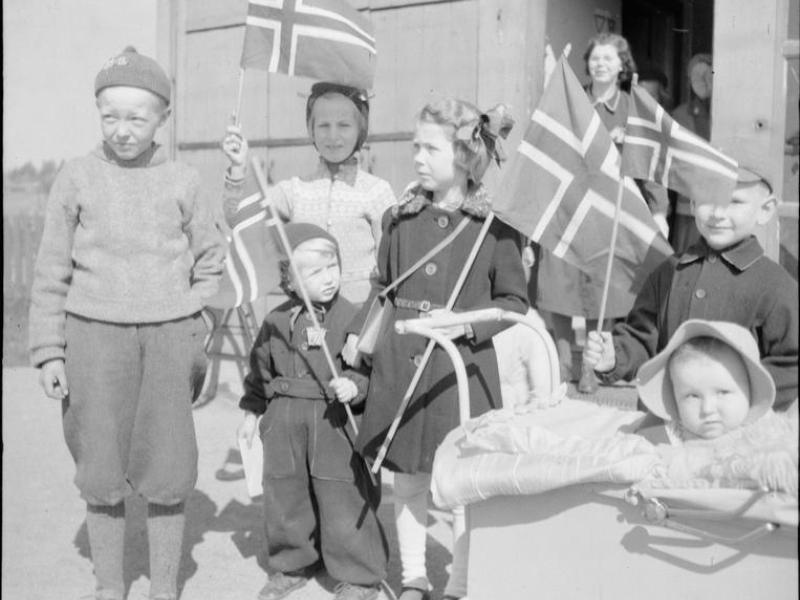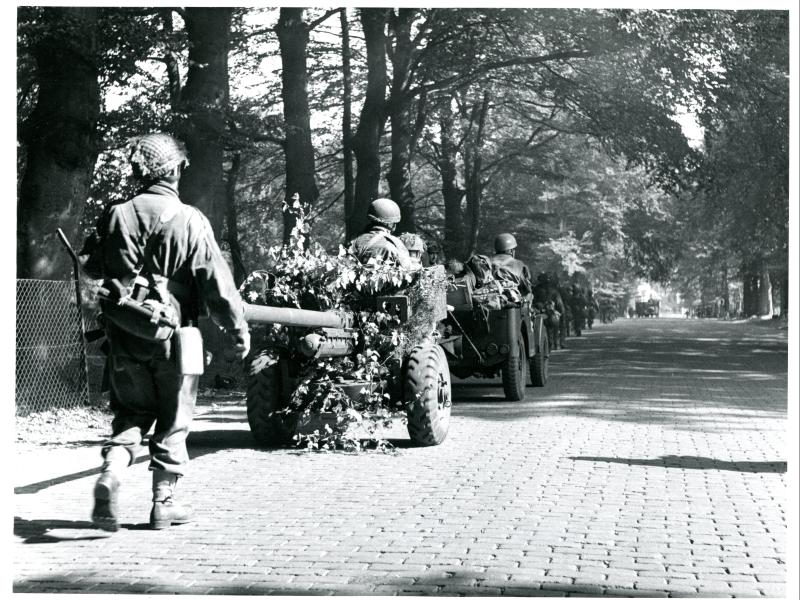Operation ECLIPSE
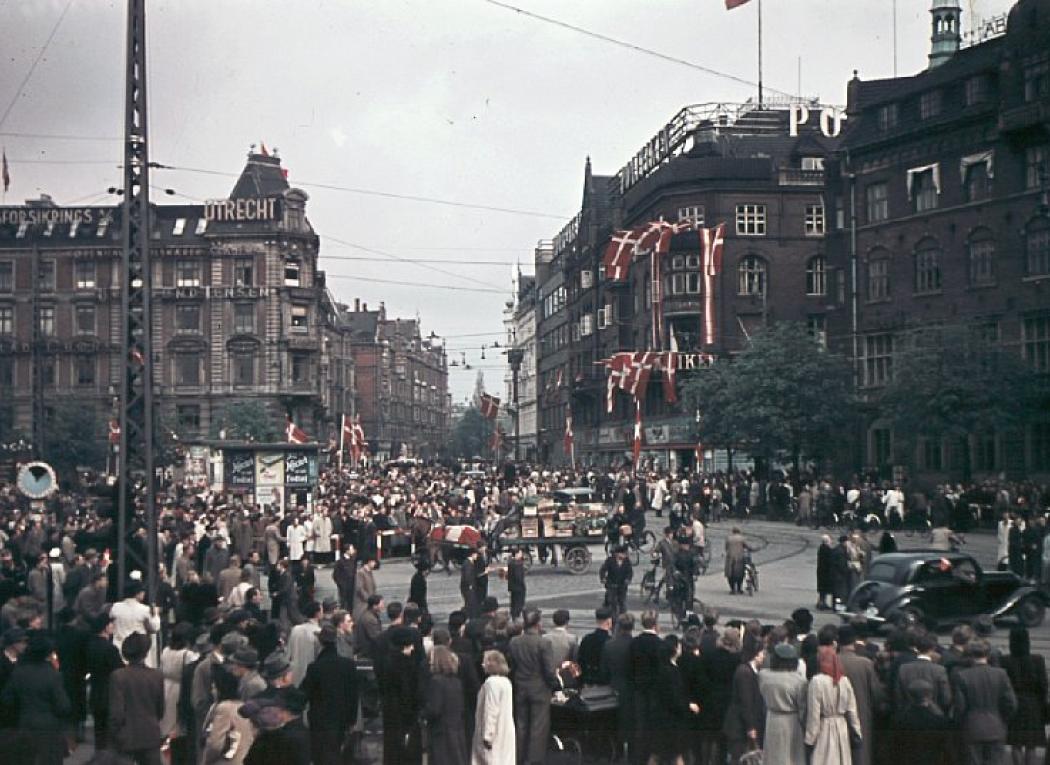
THE 'ECLIPSE' PLANS
In May 1943, British and American staff began planning military actions following a total German surrender. These actions included disarming German forces in the West, occupying strategic areas in Germany, and establishing conditions suitable for relief and rehabilitation of the liberated countries. The plans were given the codenames RANKIN, TALISMAN and finally, in October 1944, ECLIPSE.1
- ECLIPSE (I) was a contingency plan introduced in November 1944 for implementation if there were a German military collapse in North-West Europe. The plan was directed solely at the mainland of continental Europe, in particular the manner in which the occupation of Germany was to be undertaken.2
- ECLIPSE (II) was a plan introduced in spring 1945 for a landing by two Airborne Corps on Berlin (spring 1945).3
- ECLIPSE (III) was a British plan for the capture of major German ports such as Emden, Wilhelmshaven, Bremerhaven, Hamburg, Kiel, Lübeck and Wismar.4
- ECLIPSE (IV) was a plan to avoid accidental clashes between the Western Allies and Soviet forces as their armies converged in Germany. The plan established zones of occupation and lines of demarcation, which were later approved at the Allied conference at Yalta in the Crimea during February 1945. The lines of demarcation extended from Lübeck on Germany’s Baltic coast to the German/Swiss frontier, with Denmark and its islands in the Western Allies' sector.5
- 1
Kenneth O. McCreedy, ‘Planning the Peace: Operation Eclipse and the Occupation of Germany’, The Journal of Military History, 65/3 (2001).
- 2
CWMC, ‘Eclipse (I) | Operations & Codenames of WWII’, Codenames.info, 2024 <https://codenames.info/operation/eclipse-i/> [accessed 2 February 2025].
- 3
CWMC, ‘Eclipse (II) | Operations & Codenames of WWII’, Codenames.info, 2025 <https://codenames.info/operation/eclipse-ii/> [accessed 1 February 2025].
- 4
CWMC, ‘Eclipse (III) | Operations & Codenames of WWII’, Codenames.info, 2024 <https://codenames.info/operation/eclipse-iii/> [accessed 3 February 2025].
- 5
CWMC, ‘Eclipse (IV) | Operations & Codenames of WWII’, Codenames.info, 2024 <https://codenames.info/operation/eclipse-iv/> [accessed 31 January 2025].
OPERATION ECLIPSE

February 1945: British Prime Minister Winston Churchill, US President Franklin Roosevelt, and Soviet leader Joseph Stalin meet at Yalta to discuss their joint occupation of Germany and plans for post-war Europe. (US National Archives 531340/public domain)
Churchill, Roosevelt and Stalin met at Yalta in the Crimea during 4-11 February 1945 to agree future strategy and the division of post-war Germany. However, there was not complete trust among the Allies that the limits of military advances they had agreed would be respected, particularly as each nation had its eyes on the post-war situation in Europe. There were real fears that the Soviets might try to occupy Denmark, which would have given the Soviet Navy the great advantage of year-round, ice-free access to the North Sea and Atlantic Ocean, as well as the ability to affect shipping access to the Baltic Sea.6
- 6
C N Trueman, ‘Operation Eclipse’, History Learning Site, 2015 <https://www.historylearningsite.co.uk/world-war-two/world-war-two-and-eastern-europe/operation-eclipse/> [accessed 31 January 2025].
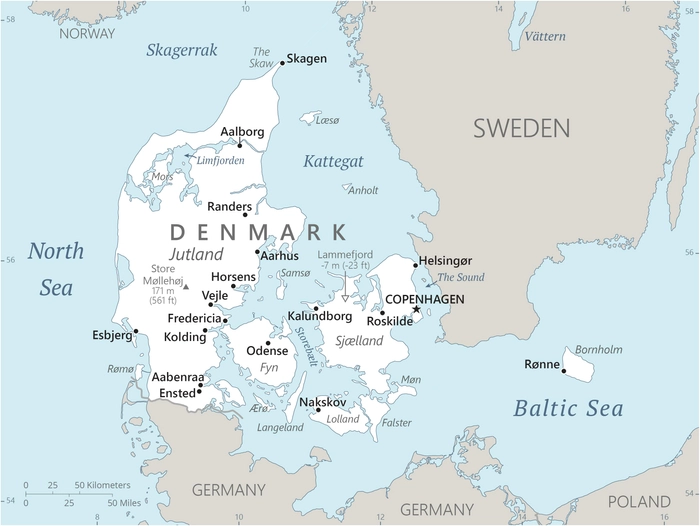
Denmark.
(The World Factbook 2024. Washington, DC: Central Intelligence Agency, 2024)
Map data ©2025 GeoBasis-DE/BKG (©2009), Google
The British and Americans received disturbing intelligence from the Swedish government that was based on intercepted Soviet signal traffic. Part of it indicated that the Soviet 3rd Guards Tank Corps had been ordered to advance beyond the Yalta demarcation line at Lübeck and force a corridor northwards through Kiel to Denmark. Both the British Americans wanted to avoid a military clash with the Soviets, but they could not allow the Soviets to occupy Denmark. Relevant parts of the ECLIPSE plans were combined to create Operation ECLIPSE, which aimed to block any Soviet advance into Denmark.7
There were three components of Operation ECLIPSE:8
- The occupation of Denmark to send a signal to the Soviet authorities that the Allies were there to stay, as agreed at Yalta.
- The securing of Kiel, a major German naval base, and important scientific bases located between Kiel and the Danish border.
- The capture of Wismar. This was the riskiest component of ECLIPSE because the Yalta Agreement had allocated Wismar to the Soviet Zone, and it was therefore a legitimate objective for the Soviet Army. The worst case scenario was that fighting might break out between the Soviet and British forces in Wismar.
On 4 May 1945, a British naval force comprising two cruisers, four destroyers and a minesweeper flotilla sailed into Copenhagen harbour, ostensibly to accept the German surrender but, in reality, to act as a deterrent against any Soviet attempt to take the Danish capital by sea. The RAF sent two squadrons of rocket-firing Hawker Typhoon fighter-bombers to airfields near Copenhagen. On 7 May, the British 1st Parachute Brigade began flying into Copenhagen, both to take the surrender of the German troops in Denmark and to act as a further deterrent to any Soviet involvement.9
In Germany, a small British Army force moved through to secure Kiel and nearby areas, and the 3rd Parachute Brigade of the 6th Airborne Division, which was advancing north-eastwards from the River Rhine, was ordered on 1 May 1945 to race forward and capture Wismar. Although the town was in the area agreed for Soviet occupation under the Yalta agreements, it was a suitable place for blocking any Soviet Army advance further westwards. Wismar was captured on 2 May, just as Soviet troops began arriving on its outskirts.
- 7
CWMC, ‘Eclipse (IV): Operations & Codenames of WWII’, Codenames.info, 2024 <https://codenames.info/operation/eclipse-iv/> [accessed 31 January 2025].
- 8
C N Trueman, ‘Operation Eclipse’, History Learning Site, 2015 <https://www.historylearningsite.co.uk/world-war-two/world-war-two-and-eastern-europe/operation-eclipse/> [accessed 31 January 2025].
- 9
CWMC, ‘Eclipse (IV) | Operations & Codenames of WWII’, Codenames.info, 2024 <https://codenames.info/operation/eclipse-iv/> [accessed 31 January 2025].
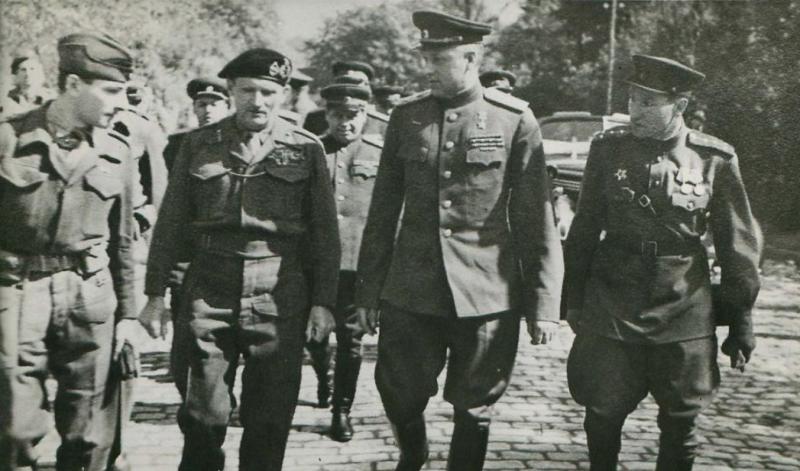
7 May 1945: Field Marshal Montgomery and Marshal Rokossovsky meet in Wismar. (Airborne Assault Museum/Paradata)
There followed a stand-off between Major General Bols, the Commander of the 6th Airborne Division, and a senior Soviet officer, who stated that his mission was to capture Lübeck. General Bols threatened to use the 6th Airborne division, supported by masses of artillery, to prevent any Soviet advance. Fortunately, the Soviet officer backed down. Over the next few days, the situation remained tense as both sides faced off each other, but meetings of their senior commanders continued. Field Marshal Montgomery arrived to meet the Soviet commander, Marshal Rokossovsky, on 7 May; on the following day, the war in Europe officially ended and this defused the situation.10 In the latter half of May, the 6th Airborne Division returned home to its bases in Wiltshire.
The British gamble had paid off: by their swift intervention, units of the Royal Navy, British Army and Royal Air Force had successfully prevented Soviet forces from occupying Denmark and gaining a strategic advantage for their navy. The Soviet Army would take control of eastern Germany but no further west.
- 10
Peter Harclerode, ‘Go to It!’ - Illustrated History of the 6th Airborne Division (London, 2000), 167.

Allied Occupation Zones in Germany from June 1945. (US Military Academy, public domain)
1ST PARACHUTE BRIGADE IN DENMARK
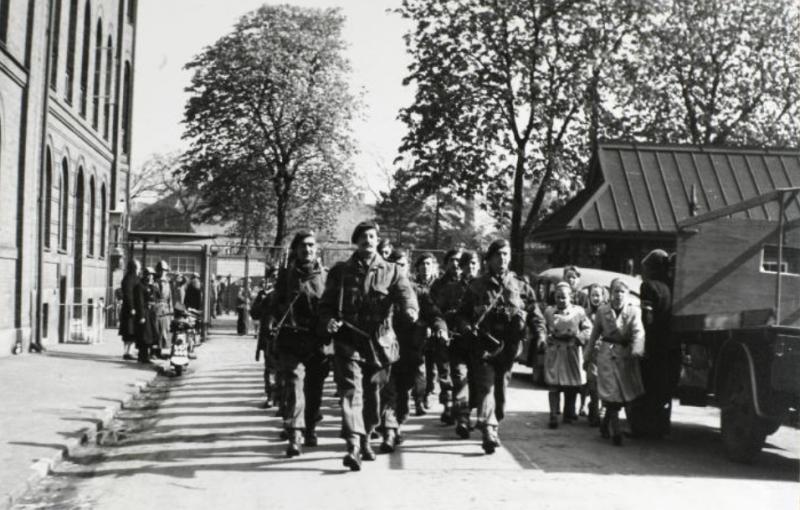
6 May 1945: troops from the 1st Parachute Brigade enter the Carlsberg Breweries in Copenhagen to assist Danish Resistance Forces collecting German prisoners. (Airborne Assault Museum/Paradata)
By spring 1945, the 1st Airborne Division had received many young and inexperienced soldiers as replacements for the men lost at Arnhem. The Division would have to be tested to confirm that it was fit for another major Airborne operation. The test would take the form of Exercise AMBER, which began in Suffolk on 3 May, but it was cut short within 24 hours because orders had come through for two of the Division’s Brigades to return to base. These were the Polish 1st Independent Parachute Brigade, which was to prepare for a move to Germany on occupation duties, and the 1st Parachute Brigade, which was to prepare to fly units into Denmark on Operation ECLIPSE. The remaining units of the 1st Airborne Division were given the task of deploying to Norway on Operation DOOMSDAY.
Before the 1st Parachute Brigade deployed to Denmark, its 2nd and 3rd Parachute Battalions were detached and left behind in the UK as a reserve. To compensate for the loss of these battalions, the 2nd Battalion of the King’s Royal Rifle Corps (motorized infantry) and the 1st The Royal Dragoons (armoured cars) would be temporarily attached to the Brigade from British forces already in Germany, and the new grouping would be called the 1st Parachute Brigade Group.
The 1st Parachute Battalion flew to Copenhagen from Saltby on 7 May 1945, and the Brigade Headquarters flew to Copenhagen from Barkston Heath on VE-Day, 8 May 1945.
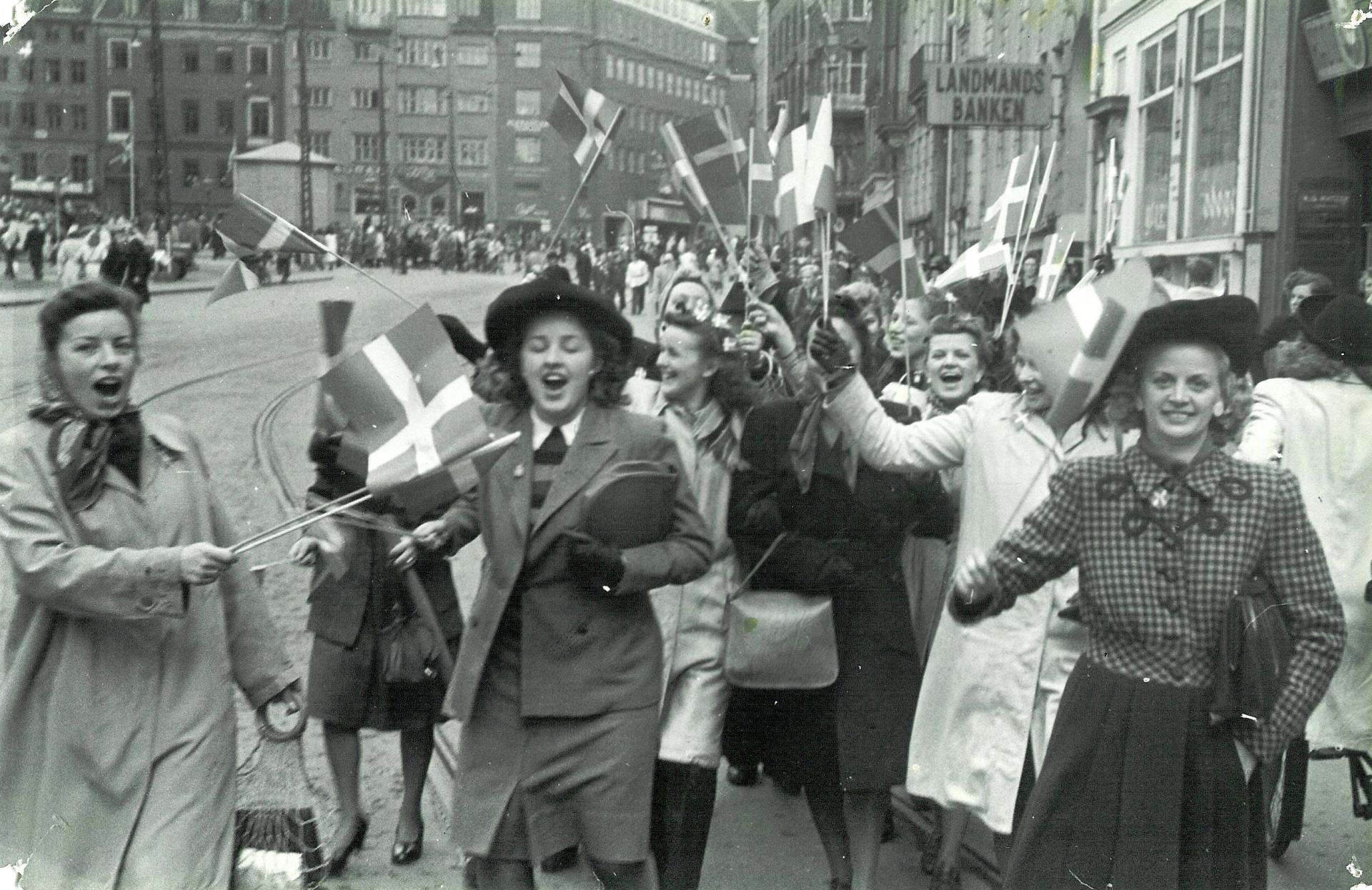
Crowds in Copenhagen celebrate the liberation of Denmark in May 1945.
(Nationalmuseet - National Museum of Denmark, CC BY-SA 2.0 <https://creativecommons.org/licenses/by-sa/2.0>, via Wikimedia Commons)
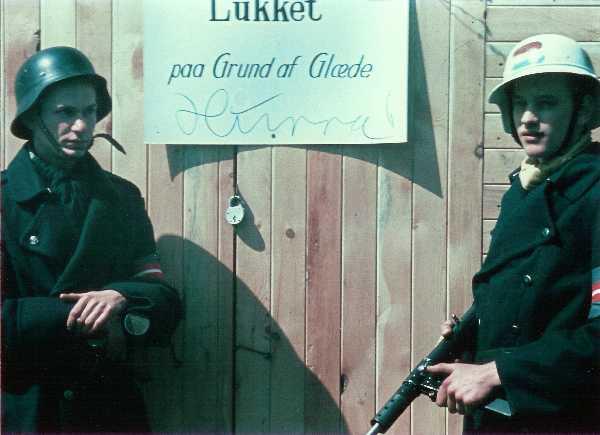
Two Danish resistance fighters guard a shop with a sign saying, ‘Closed due to Happiness’, after the liberation of Denmark by British troops. (Public domain, via Wikimedia Commons)
The tasks laid down for the 1st Parachute Brigade Group were:
- To secure Copenhagen/Kastrup airfield.
- To maintain internal security in Copenhagen.
- To disarm all German forces in the area.
- To reconnoitre to the south to meet approaching ground troops.11
On 10 May, Brigade Headquarters took control of all British troops in Denmark.12 On 15 May, the 2nd Battalion, King’s Royal Rifle Corps entered Denmark and joined the Brigade Group.
The Brigade received extensive support from Danish Resistance groups, who undertook a variety of tasks, including guarding weapons dumps. On the whole the German forces were cooperative, and they gradually evacuated Denmark in an orderly fashion.
The 1st Parachute Brigade had been deployed at short notice to provide a British military presence on the ground in Copenhagen, and to send a signal to the Soviets. It was not intended to keep the Brigade in Denmark for an extended period. Accordingly, it was decided on 22 May 1945 that the 1st Parachute Battalion would return to England by 1 June, and the Brigade Headquarters would remain in Denmark until 1 July, while arrangements were made for a longer-term transitional force in Denmark.
On 1 June 1945, the 1st Parachute Battalion, the Brigade Commander and other elements of the Headquarters returned to England. Remaining elements of the Brigade Group gradually left Denmark, with the last staff of the Brigade Headquarters arriving at Tilbury on 30 July, from where they returned to Lincolnshire.
As part of post-war military cuts, the 1st Airborne Division - including the 1st Parachute Brigade - was to be disbanded. Its men were to be demobilized or transferred to the 6th Airborne Division, which would be deployed to Palestine on peace-keeping duties.
The remaining time before 1st Airborne's disbandment was taken up helping train men for the 6th Airborne Division and carrying out the necessary administrative actions associated with disbandment.
On 15 November 1945, the 1st Airborne Division was disbanded, passing into legend.
For more information on Operation DOOMSDAY, click here:
BIBLIOGRAPHY
1st Parachute Brigade Headquarters, War Diary, May 1945 (The National Archives, WO 171/592)
CWMC, ‘Eclipse (I) | Operations & Codenames of WWII’, Codenames.info, 2024 <https://codenames.info/operation/eclipse-i/> [accessed 2 February 2025]
———, ‘Eclipse (II) | Operations & Codenames of WWII’, Codenames.info, 2025 <https://codenames.info/operation/eclipse-ii/> [accessed 1 February 2025]
———, ‘Eclipse (III) | Operations & Codenames of WWII’, Codenames.info, 2024 <https://codenames.info/operation/eclipse-iii/> [accessed 3 February 2025]
———, ‘Eclipse (IV) | Operations & Codenames of WWII’, Codenames.info, 2024 <https://codenames.info/operation/eclipse-iv/> [accessed 31 January 2025]
Dear, Ian, and M R D Foot, The Oxford Companion to the Second World War (Oxford, 1995)
Hallows, Ian S, Regiments and Corps of the British Army (London, 1991)
Harclerode, Peter, ‘Go to It!’ - Illustrated History of the 6th Airborne Division (London, 2000)
Hastings, Max, Armageddon, Paperback (London, 2005)
Joslen, H F, Orders of Battle, Second World War 1939-1945, Reprint (Uckfield, 1990)
McCreedy, Kenneth O., ‘Planning the Peace: Operation Eclipse and the Occupation of Germany’, The Journal of Military History, 65/3 (2001)
Otway, Terence B H , Airborne Forces of the Second World War, 1939-45, Facsimile of War Office publication of 1951 (Uckfield, 2019), 324–29
Trueman, C N, ‘Operation Eclipse’, History Learning Site, 2015 <https://www.historylearningsite.co.uk/world-war-two/world-war-two-and-eastern-europe/operation-eclipse/> [accessed 31 January 2025]
